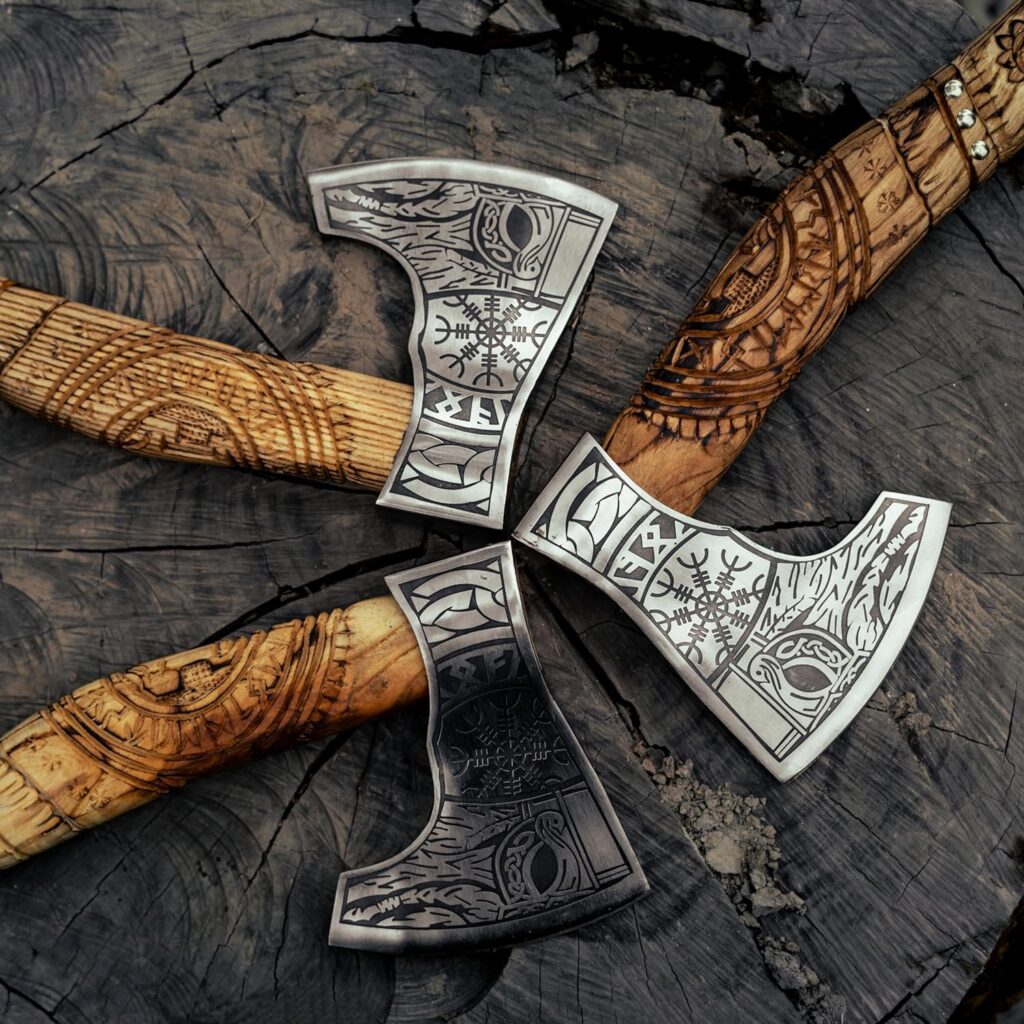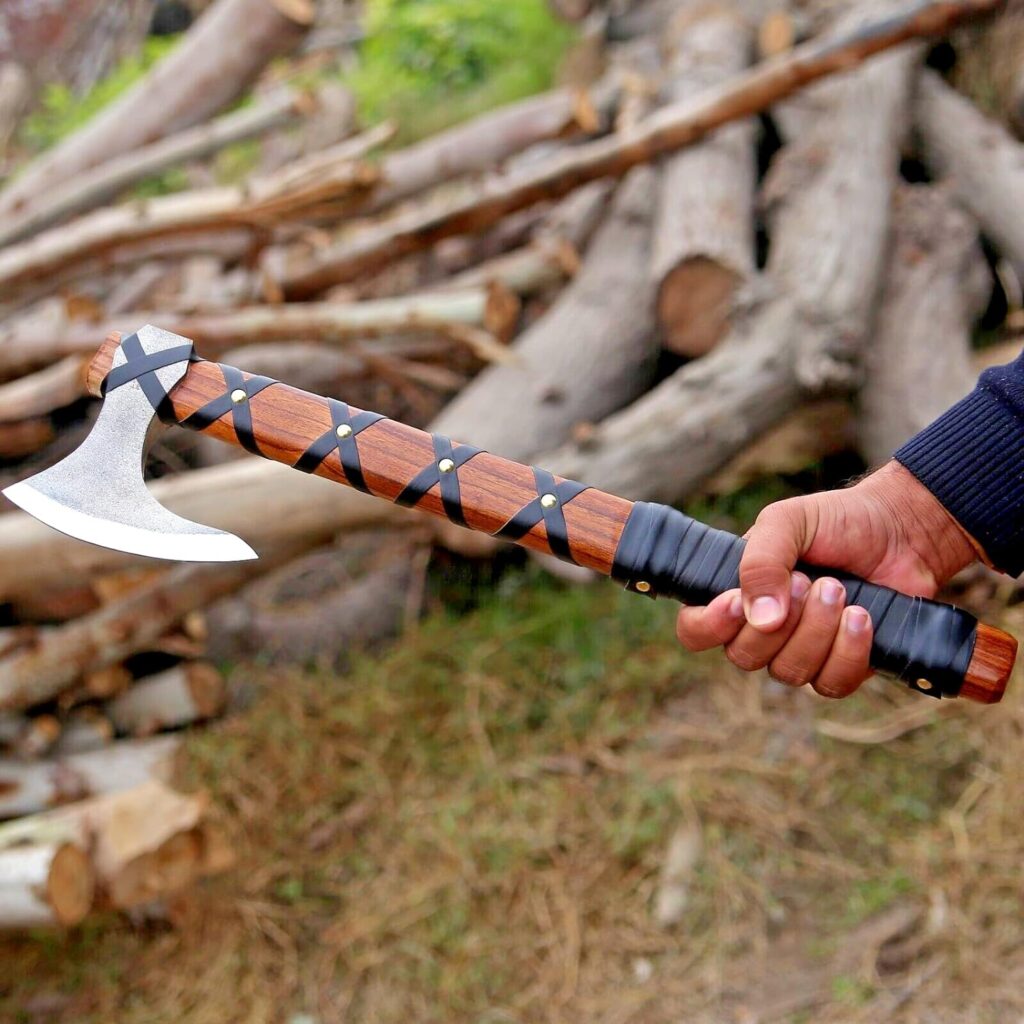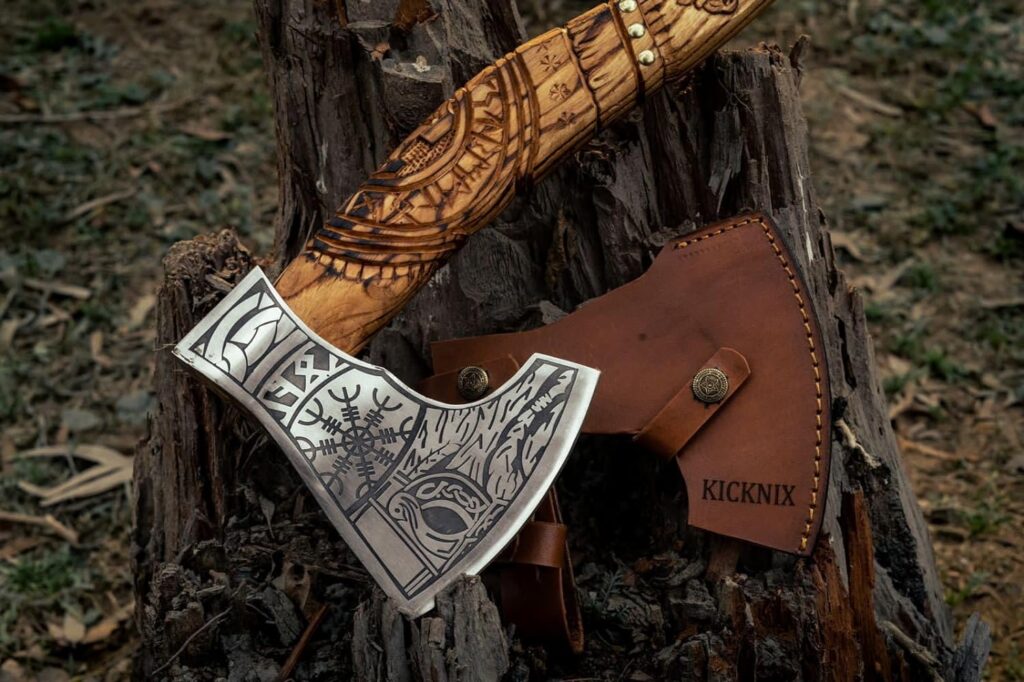- Free Shipping and 100 days free returns.
The story of the Viking axe is one of evolution, innovation, and masterful craftsmanship. Told by Vikinggear From its early use in prehistoric times to the highly refined tools of today, the making of a high-quality axe is a blend of art and science. This article delves into the intricate craftsmanship involved in creating a top-notch Viking axe, from selecting the right materials to the final product that stands the test of time. So Let’s get Started
The Viking axe’s blade is its main part, and the material selection affects how well it works. Superior Viking axes are often made of stainless steel or high-carbon steel. For hard tasks like wood cutting, high-carbon steel is recommended due to its durability and ability to keep a sharp edge. Although stainless steel is not as durable, it is more resistant to rust and corrosion than other materials, which makes it helpful in humid or moist environments.
The axe’s handle needs to be flexible. Best Viking axe handles are fashioned from hardy, durable woods like ash and hickory. Hickory is especially valued for its ability to absorb shock while remaining strong and flexible. Another great option is ash, which is renowned for its strength and low weight. Modern composites and fiberglass handles have become more and more popular in recent years because of how well they weather and how little maintenance they require.
Quality control is Everything if the product doesn’t have that in it Then the p/;roduct Standard goes down in the selection of materials for high-quality axes. Premium materials ensure the Viking weapons can withstand anything and last for generations. Every part needs to be carefully examined and tested for flaws. Both the steel and wood need to be pure, with no impurities, and a straight grain free of knots. The difference between mass-produced instruments and high-quality axes is their attention to detail…

Prototyping and design are the first steps in making a high-quality ‘ppaxe. During the design phase, intricate blueprints with the Viking’s axe size, weight, and balance are created. Craftsmen can test these ideas and make any necessary improvements through prototyping. This stage guarantees that the finished product satisfies the intended performance requirements.
The steel is heated to a high temperature until it becomes pliable, which is the first step in the forging process. Usually, a forge is used for this, as temperatures there can approach 2,000 degrees Fahrenheit. The steel is heated and then hammered to take on the rough shape of the Viking’s axe head. This is a skill-and precision-demanding operation because the blade’s shape will determine how well it cuts.
The Viking axe head gets tempered and hardened after shape. In this procedure, the steel is heated to a predetermined temperature and then quickly cooled—typically by quenching it in water or oil. By tempering the steel, it becomes less brittle while retaining its hardness, allowing the blade to withstand severe use without breaking or chipping.

The wood must be strong, flexible, and capable of absorbing shocks.for best viking axe Hickory and ash are preferred for their exceptional qualities. The wood is carefully selected, often from the heartwood of mature trees, which provides the best balance of strength and flexibility.
After the wood is chosen, it is formed into the handle by combining conventional and cutting-edge techniques. The handle is traditionally carved by artisans using spokeshaves and drawknives to provide a secure grip and ideal balance. To achieve the ideal fit and feel, today’s methods frequently involve the use of CNC machines for precise sculpting, but manual finishing touches are still common.
A crucial step is securing the handle to the axe head. Using wooden or metal wedges, the handle is traditionally inserted into the axe head’s eye and fastened. This results in a snug fit that keeps the head from slipping off while being used. To add extra security, certain contemporary axes are coated with epoxy or other adhesives. The idea is to establish a strong, safe bond to survive the pressures applied during splitting and chopping.
The initial sharpening of the combat axe blade is done by grinding the edge to a fine point. This process requires precision, as the angle of the edge must be consistent to ensure effective cutting. Many high-quality Viking weapons are sharpened by hand, using a combination of grinding wheels and sharpening stones to achieve a razor-sharp edge.
The blade is polished to smooth out any sharp edges and improve its appearance once it has been sharpened. To stop rust and corrosion, a protective coating like oil or lacquer is then applied. To preserve the wood and bring out its inherent grain, the handle is also coated with oil or varnish.
A Viking axe is put through extensive quality assurance testing before it is considered finished. These tests guarantee that the axe’s overall balance and ergonomics satisfy strict requirements, the handle is firmly fastened, and the blade is sturdy and sharp. The axe can only be sold if these inspections are passed.

For those who seek something truly unique, bespoke Viking axes offer a personalized touch. Custom-made axes are tailored to the specific needs and preferences of the user. This process involves close collaboration between the craftsman and the customer, resulting in a tool that is not only functional but also a work of art.
Profiles of master axe makers highlight the artistry involved in crafting high-quality axes. These artisans bring years of experience and a deep understanding of materials and techniques to their work. Their dedication to their craft results in Viking battle axe that are both beautiful and highly functional.
Fine, handcrafted Viking axes are often highly valued by enthusiasts and collectors. These axes are the pinnacle of workmanship because they mix traditional techniques with modern innovations. Collectors appreciate the unique characteristics and fine craftsmanship of each handcrafted Viking axe.

A fine axe is crafted through a process that combines tradition and innovation, science and art. Every stage is essential to producing a tool that is both beautiful and useful, from choosing high-quality materials to careful forging and finishing techniques.
An artisanal Viking axe bears witness to the expertise and commitment of its creator, serving as more than just a useful tool.